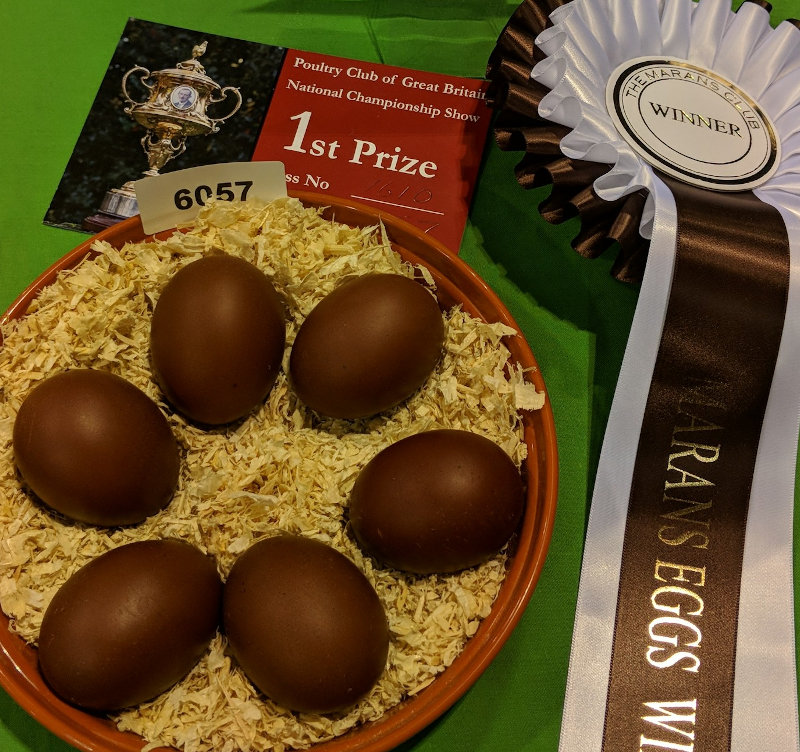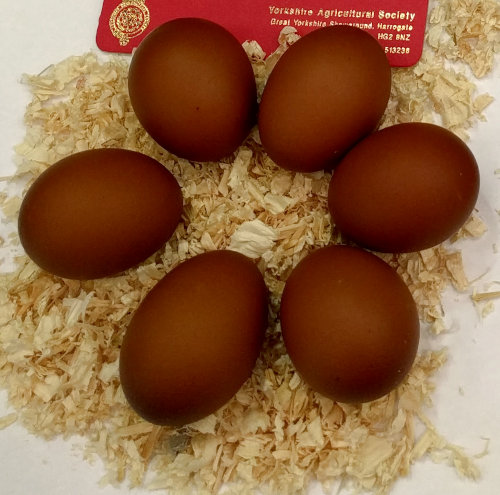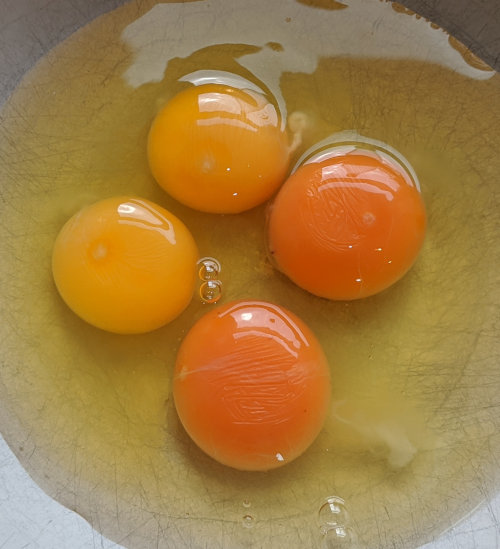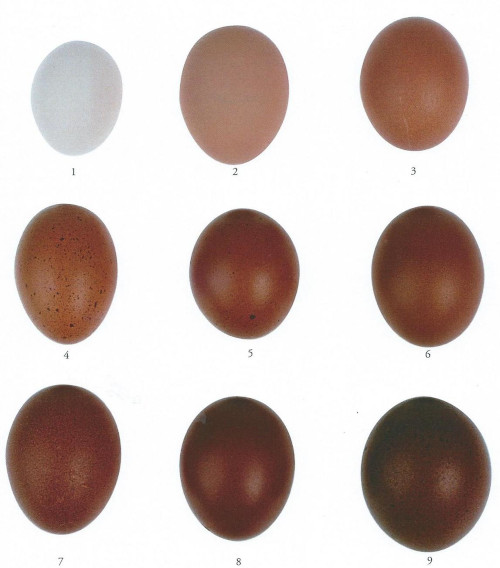The Marans dark brown eggs.

Table of Contents
- What are Marans eggs?
- Are Marans good egg layers?
- Do all Marans lay dark eggs?
- Do Marans eggs taste different?
- At what age do Marans start laying eggs?
- How long do Marans chickens lay eggs for?
- Why brown eggs are more expensive?
- Marans egg colour chart:
- How to breed Marans for the best darkest eggs:
- Why don't my Marans lay dark brown eggs?
What are Marans eggs?
Marans chickens are well known for laying dark brown, almost chocolate coloured eggs. I've heard them referred to as "the most expensive chicken eggs in the world" and until recently they have been fairly hard to come by. They are said to be prised by both James bond and French chefs and are slightly harder to hatch then other breeds.
The criteria to be evaluated for Marans eggs are:
- The colour according to the scale, which should be uniform over the entire surface.
- The size. The egg should weight at least 65g.
- The form must be oval and not very pointed or round and have a shiny shell.
- The inside of the eggs is also evaluated for the golden yolk, the presence of blood stains, the consistency of the egg white.
The defining characteristic of this breed is the large, chocolate brown eggs they lay. The brown colour in Marans' eggs is the result of a layer of pigment deposited over a finished egg as it passes through the oviduct.
Below: A selection of Marans eggs.

This is different from other grocery store brown eggs, which are much lighter and chalkier in colour, and in which the tan pigment is built into the shell calcium. In the case of a "grocery" brown egg, the colour cannot be diminished by washing with water, whereas with a Marans egg, the coating may be scrubbed off using water.
The coating on a Marans egg may be smooth colour, stippled, or even with larger spots, because it is the result of how the layer of pigment is deposited by glandular secretions as the egg moves through the oviduct.
The genetics of what makes the chocolate brown egg are not well understood at all. It is thought that several genes may be involved, all playing some role in the final outcome of egg colour.
Breeding for the darkest coating on the eggs is desirable, but difficult, since the genetics are not well understood. The best results are obtained by breeding pairs from the darkest eggs, and who lay the darkest eggs for the longest period.
Are Marans good egg layers?
On average a Marans hen will give you around 3 eggs per week, which works out to around 150-200 eggs per year. This makes Marans an average layer in quantity, but the quality of the egg is said to be unsurpassed.
The hens' are said to good setters and mothers but not overly broody. In comparison to modern hybrid layers, Marans are quite poor producers.
It is up to the breeder how he will proceed with the selection and whether he will prefer the darkest possible eggs at the expense of the exterior, which over time may have nothing to do with the breeding standard. With the increasing darkness of the shell, a rapid reduction in laying must also be expected.
Egg formation takes approximately 25 hours. Approximately 90 minutes before the egg is laid, the formation of the shell is stopped and the dye is applied. If the laying hen is exposed to a stressful situation during this period, the shell may fade to premature laying and the pigment may not be applied at all.
Do all Marans lay dark eggs?
All Marans birds lay a dark brown egg, but the Black Copper is sought after for its' egg colour being especially chocolatey. The fewer eggs a Black Copper hen lays, the darker the colour.
The shell itself is white, during formation a liquid dye is applied to it - protoporphyrin-IX.
This dye is produced in the last 10cm of the oviduct in the glandular epithelium. It is synthesized from a blood pigment that has been part of red blood cells. The dye dries quickly after contact with air after application, but at that time it can be wiped off with a finger.
The longer the egg is in the oviduct, the darker it is. The size of the egg and its shape also affect its colour. The rounder eggs remain in the egg tube a little longer than the ovals and can thus absorb more dye. Due to the fact that most breeders try to hatch the darkest possible eggs, it has made a rounder egg typical of Marans.
It is said that the amount of dye which a laying hen can produce per egg is constant. Thus, large eggs tend to be paler than small ones with a smaller surface area.
The genetic nature of brown eggs is not fully understood, as it has never been studied in sufficient detail. Not at all with the extra dark ones as Marans, Welsummers, Barnevelders or Penedesenca. The colour is thought to be directly affected by 12-14 genes.
All breeds whose eggs have a brown or white shell carry two autosomal recessive alleles, called wild type - (o + / o + ) - located at the blue locus of the shell. Hens that carry these alleles lay eggs with a white shell. The "O" allele decides whether the hen will lay eggs with a white or blue shell. Blue eggs carry O / o + heterozygotes and O / O homozygotes. But there are other genes that cause brown or green staining. In addition, genes are known to block brown shell formation. This means that even hens that lay white eggs may have genes for brown shell formation, but the expression of this gene is blocked by another gene and so the hen lays white eggs.
Do Marans eggs taste different?
They look different and that can have a psychological effect on the taste of food.
In a blind taste testing I did with three of my friends and all my family no one could tell the difference between Marans eggs, store bought eggs and the eggs from the rest of my flock.
Below: A comparison of two Marans eggs with ordinary hybrid layers. Marans are bigger and better coloured.

They do look different and I know which eggs I would rather be eating but they taste the same.
At what age do Marans start laying eggs?
Marans are slow to develop and will start to lay eggs at 32 weeks of age.
How long do Marans chickens lay eggs for?
A Marans hen is typically productive for 5 years and will produce about 700 eggs in her lifetime.
Why brown eggs are more expensive?
- Chickens that lay brown eggs produce fewer eggs per year but still eat the same amount of feed.
- The dye on the shell is so thick it partially clogs the pores in the shell reduce the hatch rate by some margin.
- The coating can slow the evaporation of water from the egg during incubation which means that the chicks can be too big to hatch successfully.
This makes brown egg layer more difficult to produce and more expensive to feed, all for a chicken that lays fewer eggs.
Marans egg colour chart:
In order to determine the colour of the shell, the French Marans Breeders' Club issued an official colour scale in 1993 , recognising nine degrees of colouration. According to her, only hens laying eggs of grade four and above are considered Marans.
Below: The Marans egg colour chart:

To qualify as a Marans, a layer must be able to produce a number 4 or darker egg reliably for a period of her laying season.
The French do not even grade egg colour on newly laying pullets until they have produced at least a dozen eggs, then they rate the eggs that come after the first dozen.
This helps to disqualify the pullet whose first eggs may be slow through the oviduct, thus resulting in abnormally dark colour that later in her life is never reproduced again.
Below: The darkest Marans eggs I produce. Average day to day eggs range from 6 to 8 on the scale.

How to breed Marans for the best darkest eggs:
But what we ultimately breed for in Marans is for the tunnel with the heaviest spray painting! Through some combination of genetics, diet, hormones, low-stress, and healthy light exposure, some hens produce more "paint" more consistently than others.
When evaluating a hen, or a flock, for egg quality, one has to look over time to see what eggs they produce, and for how long.
A hen that lays a single spectacular egg is of little use to breed, because that egg is most likely the result of an abnormal condition, such that it got caught up and slowed down in her oviduct.
What we need to breed for is the hen whose oviduct consistently produces a lot of pigment, over many eggs. The hen to choose for a breeding program is the one who consistently produces many fairly dark eggs, for a long part of her season, and for more than her first laying season.
Marans are carriers of a special genetic mix that causes extra dark colouration. If it were enough to hatch from dark eggs, so that the offspring would also lay dark eggs, all breeders would have hens that lay beautiful dark eggs.
The rooster also has a significant effect, so it is important to know its origin and know what eggs it comes from. One badly chosen cockerel can ruin your whole breeding program.
The shell is dark red, chocolate red with a hint of purple. With a distinctive shine with the highest quality eggs. We distinguish three possible types of colouring. Uniform colouring of the whole shell, pigmented - dotted and the shell with larger or smaller uneven spots of a darker colour. Stains and dots should always be darker in colour than the background.
A breeder attempting to cross might develop a better layer, but production would come at the sacrifice of egg colour. The genes for the deep, dark egg colour appear to be somewhat recessive, in that the egg colour will disappear after such a crossing. It is then very difficult to regain the original egg colour. The unique colour of the eggs is also linked to the laying period the longer an egg remains in the oviduct, the darker it will be.
Better layers generally have poorer shell colour.
Why don't my Marans lay dark brown eggs?
The ability to lay dark eggs waxes and wanes. The pictures you see of beautiful dark eggs are the best of what the hens lay, and no hen will lay such eggs every time.
Egg colour is related to diet, hormones, age, light exposure, and genetics. We do know that throughout a hen's laying cycle, the first eggs are typically the best, and she may then go on to lay eggs of lighter colour, which can then darken again after a laying rest, or after a period of broodiness.
If you think of her oviduct as a spray-paint tunnel, then conditions that slow down the speed of each egg through the tunnel, or cause fewer eggs to pass through the tunnel, will enable more "painting" on the egg, and therefore a better, darker colour. Conditions that cause lots of "painting" ,such as many eggs in a row with no days to re-build pigment supplies, will use up the paint reserve, leaving only what can be generated on the spot to "paint" onto the eggs.
External factors also affect the colour of the shell, sometimes a new pullet who is just starting to lay will have an egg "stall" going down her oviduct, giving the egg an abnormally long time to get coated, making for an abnormally dark egg. But further into her laying career, she is never able to produce these eggs again.
Age of laying hens:
It often happens that in young hens starting to lay eggs, the eggs get so-called stuck and spend more time in the Fallopian tube. During this time, more dye is applied to it, resulting in extra dark eggs. The colour is therefore evaluated at the earliest after twenty laid eggs.
It is ideal if the hen lays eggs of the same colour throughout the laying period. However, this is not common in practice. The colour fades during the laying cycle and after washing, the dark colour re-emerges. Older laying hens lay larger eggs than younger ones. However, the amount of pigment is the same. Because larger eggs have a larger area, they are paler than smaller eggs.
Stress:
Stress is another factor that fundamentally affects the colour of the shell. It can cause fading, but also pinkish discolouration or dark spots. The pink colour is usually caused by dusting of amorphous calcium carbonate on the surface of the shell. Fear is one of the most common stressors. There can be many triggers: loud noise, animal transport, trapping, changing in the flock, predators, overcrowded chickens and paddocks.
Parasites, temperature fluctuations and feed changes have a stressful effect and also cause the shell to fade.
Medication:
nicarbazine (coccidiostats) and antibiotics can cause rapid discolouration of the shell. In nicarbazine trials, it took approximately 3 days for the brown shell to turn white and a few days for the colour to return after treatment. Diseases such as infectious bronchitis also cause the shell to fade.
Nutrition:
Some enzymes and feed additives, used mainly in complete feed mixtures can cause the shell to fade.
I Feed on organic pellets, quality mixed seed scratch, natural dried seaweed for minerals and allow to free range for best egg results.
